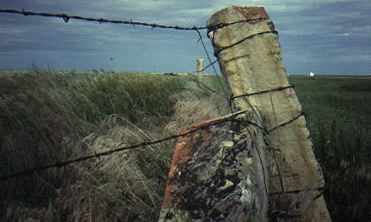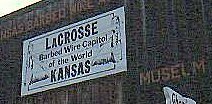Thursday, June 14, 1984
Hutchinson to La Crosse, Kan.
113 miles
Locator map
I’m reprinting the day-to-day journal entries of a cross-country bike tour my friend and I took in 1984. More about the TransAmerica Tour 1984
Gene’s Journal
We’re sitting here writing in our journals at a picnic table that’s about 30 miles south of the geographical center of the US.

We clicked off a lot of miles today, and I am tired and a little sore, but I feel like I could charge across more than 100 miles of Great Plains again tomorrow.
We left Hutchinson early in the morning and made it to Nickerson early enough to run into a couple, ages 58 and 52, who spent the night in the home of a stranger who was worried about them camping in the park with tornado warnings broadcast. They too were amazed by how many people help the bicycle tourists.
We picked up the TransAmerica route here and pedaled it through the dream-like flat landscape of the Quivira National Wildlife Refuge. It sits atop one of the world’s largest underground salt deposits, so I am told. Stopped midway to talk with a couple heading east on their bikes; they lived not far from my home of Annapolis, Maryland.
Rock posts and barbed wire
We didn’t pass a town after Nickerson for about 60 miles, all the way to Larned. We stopped here, home of historic Fort Larned, for about an hour and replenished on iced tea. When we left, we entered what’s known as the post rock country — where ranchers had used quarried limestone instead of wood as posts to support the barbed wire fences. Lots of limestone back then, not much wood.(The photo above shows one of these limestone posts; the white dot in the distance is a grain elevator about 10 miles away.)
We caught a tailwind riding to Bison, on the edge of the Smoky Hills (hills is a relative term here), and stopped for a beer. The bartender told us about the wheat farming business, and about farmers who will race wildfires in their combines to harvest their crop when danger threatens.
The grain elevators store corn, wheat, whatever is the current crop. You can see them for 10 or more miles across the flat landscape.
Out here, they sit on the Atchison, Topeka, and Santa Fe Railroad line and the business districts spring up at the base of the elevators. It’s the rail line, not the highway between towns, that is the “main street” for commerce in these small towns.
We finally reached La Crosse, labeled the Barbed Wire Capital of the World. We camped at the City Park, took free showers at the city pool, ate spaghetti, and walked over to the Dairy Queen for dessert.
Headline: June 14, 1984 —
Navajos in New Mexico resist plans
to mine coal on homeland in the San Juan River basin
Bruce’s Journal
We were up at 6:30 this morning and covered 113 miles to Lacrosse. We had a tail wind our last 40 miles, the first sustained favorable wind we have seen and it was phenomenal. Our first leg to Larned was almost 70 miles and only one town to stop in along the way. We came within five minutes, I’d guess, of a nasty storm, but we lucked out and just missed it.

All these small towns, Nickerson, Buhler (?), Bison, Lacrosse, have grain elevators, and you can see them from miles away. They look so close, but they aren’t. It’s just that you can see for miles.
Camped at the city park, across from the city pool. They let us swim and shower there when we got into town at 7:30.
Another spaghetti dinner, but we had dessert across the street at the Dairy Queen (root beer floats never tasted so good). That was where the older woman, perhaps in her late 40s, was in line in front of me at the outdoor walk-up, and a huge bug that looked like a 32nd scale model of a helicopter landed on her shoulder. I would have jumped a mile, but she nonchalantly tweezed the insect with her fingers and gave it a subtle toss. What hardy people these Kansas people are!
LaCrosse also has a museum of the stone fences. When this area was first settled, farmers had no lumber for fences because there were no trees. So they made their fences (ingeniously) from stones and they are still in use today. Interesting to look at.
Tomorrow:
Day 34 — “Eating across Kansas”

Recent Comments